SPEKTRA has the following for modal analysis, fatigue tests and seismic simulation:
- Vibration Control Systems (VCS): A family of vibration control systems for environmental simulation tests using vibration test systems.
- Modal Exciters: A wide variety of vibration and shock exciters, which can be used to apply defined dynamic forces to larger mechanical structures for modal analysis.
- Power Amplifier: The amplifiers have features which make them uniquely suited for studying the dynamic characteristics of structures. They may be operated in either voltage or current amplifier mode.
- Accessories: for the different modes of operation and facilitate handling of equipment
- Software: LabVIEW-based software perfect match to National Instruments Hardware.
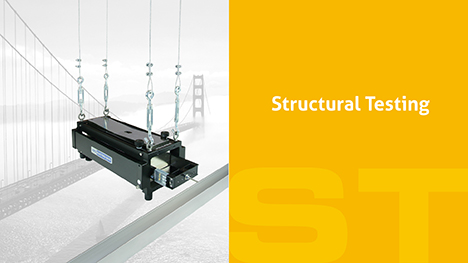
Featured Products
Vibration Control Systems (VCS)
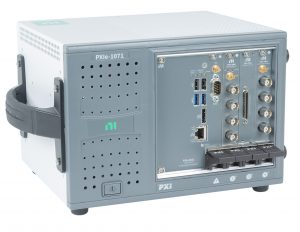
VCS 403
For exact controlled excitation in the low or high frequency range for up to 10 different vibration exciters. Powerful for vibration tests in the modes sine, random, shock or time signal repetition. The VCS 403 is a scalable, flexible and customizable vibration control system. It enables the acquisition, transmission and recording of data in real time via a selectable, standardized NI hardware base with various software options.
- Multi-channel operation up to 10 vibration exciters
- Controller for vibration test modes: sine, random, shock, time signal replication
- Frequency Range:
– Sine: 0.1 Hz – 50 (95) kHz (extensions on request)
– Random: 1 Hz – 50 (95) kHz, 5 000 (10 000) lines
– Shock: Half-sine, trapezoid, sawtooth, custom; 0.25 ms – 40 ms
- Hardware Base: National Instruments PXI

VCS 400
Providing well controlled vibration with an exciter in low frequency range. Powerfull for vibration tests, modal excitation or production tests for example. The VCS 400 is a scaleable, flexible vibration control system with variable number of measurement and control channels. It allows data to be captured, transmitted and recorded in real time via a standardized NI hardware basis.
- Controller for vibration test modes: sine, random, shock
- Frequency Range: 0.1 Hz – 10 kHz (Sine)
- Hardware Base: National Instruments PXI
Modal Exciters & Components
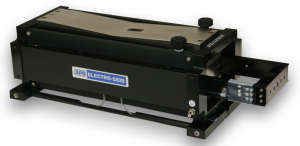
APS 113
Ball-bearing ELECTRO-SEIS® Long-Stroke vibration exciter for modal analysis of oscillatory structures.
- Frequency Range: DC – 200 Hz
- Max. Force: 133 N (optional: 186 N)
- Max. Displacement (peak-peak): 158 mm
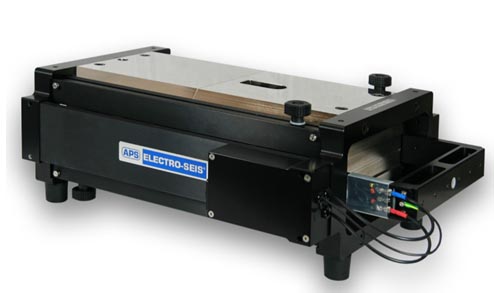
APS 400
ELECTRO-SEIS® Long-Stroke vibration exciter with 450 N max. force that is suitable for excitation of large structures such as ceilings or bridges.
- Frequency Range: DC – 200 Hz
- Max. Force: 445 N
- Velocity (Sine Peak): 1000 mm/s
- Max. Displacement (peak-peak): 158 mm

APS 420
The strongest ELECTRO-SEIS® Long-Stroke vibration exciter to date is used for vibration tests of airplanes and other large structures. With a maximum force of 900 N and up to 150 mm stroke the shaker unlocks a new performance level.
- Frequency Range: DC – 200 Hz
- Max. Force: 900 N
- Velocity (Sine Peak): 1000 mm/s
- Max. Displacement (peak-peak): 150 mm
Power Amplifiers
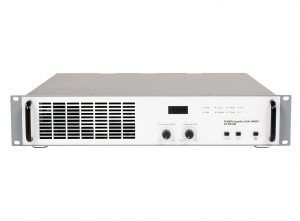
PA 500 DM
For all vibration exciters that require a 500 VA power amplifier (load impedance 4 Ω). The PA 500 DM offers a max. frequency range from DC to 200 kHz, small harmonic distortion, excellent stability even with temperature or supply line variations and helpful protection functions.
- Frequency Range: 40 Hz to 60 kHz (at full power), DC to 200 kHz (small signal)
- Power output, max.: 500 VA into a 4 Ω resistive load
- Switch between voltage and current mode
- Phase shift (0° or 180°)
- Variable gain control
- Current limit control
- Temperature protection
- Range of Use: R&D departments in industry, environment testing laboratories, calibration laboratories, universities and research institutes
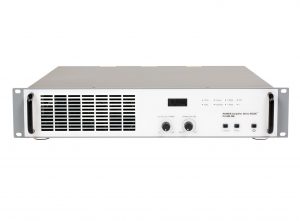
PA 800 DM
For all vibration exciters that require a 810 VA power amplifier (load impedance 2.5 Ω). The PA 800 DM offers a max. frequency range from DC to 25 kHz, small harmonic distortion, excellent stability even with temperature or supply line variations and helpful protection functions.
- Frequency Range: 20 Hz to 15 kHz (at full power), DC to 25 kHz (small signal)
- Power output, max.: 810 VA into a 2.5 Ω resistive load
- High reliability operation
- Switch between voltage and current mode
- Phase shift (0° or 180°)
- Variable gain control
- Current limit control
- Temperature protection
- Multifunction OLED display
- Range of Use: R&D departments in industry, environment testing laboratories, calibration laboratories, universities and research institutes
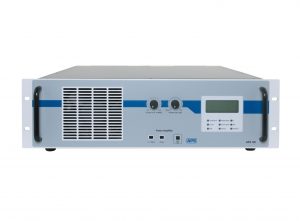
APS 145
800 VA power amplifier for low-frequency vibration exciters
- 800 watt power amplifier for modal shakers and environmental analysis
- DC coupled amplifier
- voltage and power mode
- fitted to suit the vibration exciters APS 400, APS 420 and APS 600
- safety appliances fitted to used exciter
Accessories
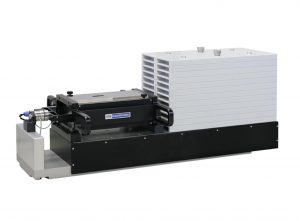
APS 4001
The APS 4001 – Horizontal Reaction Mass System provides a means of extending the rated force output for the APS 400 Shaker to frequencies as low as 0.5 Hz.
- Horizontal excitation with 400 N rated force from 0.5 Hz – 20 Hz
- Up to 700 kg reaction mass attachable
- Easy to disassemble and transport to a test location
- Can be equipped with a reference force transducer (option)
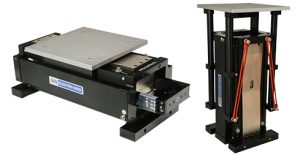
APS Auxiliary Table Kits
- Available for APS 113, APS 400 & APS 420
- Horizontal and vertical excitation
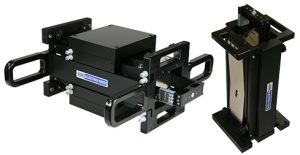
APS Handles & Bars
Handles suitable for vibration exciter APS 113
- Available for APS 113, APS 400, APS 420
- for easier transport & handling
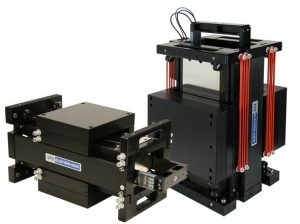
APS Reaction Mass
- Available for APS 113, APS 400, APS 420
- Improve the performance of the shaker
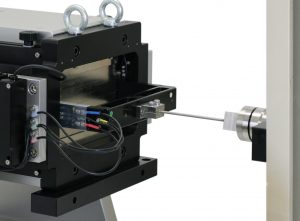
APS Modal Stinger Kit
- Designed to deliver an axial force to the test structure and help decouple cross-axis force inputs coming from curvilinear shaker/structure motion
- Available for APS 113, APS 400 & APS 420
- to apply force to a structure under test
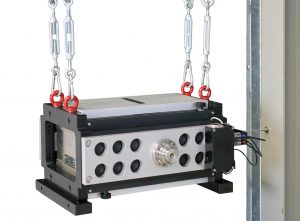
APS Steel Cable Kit
- Needed to use the shaker in operation mode “Free Body Mode”
- Available for APS 113, APS 113-AB, APS 400, APS 420
- This accessory for the APS 113 shaker provides four sets of suspension lines to use the shaker in Free Body Mode.
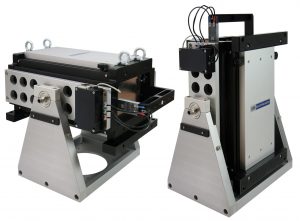
APS Trunnion Base
Trunnion base allows easy set-up in any axis from vertical to horizontal
- Available for APS 420
- Trunnion Base allows the APS 420 ELECTRO-SEIS® Shaker to be set up in any axis from vertical to horizontal.
Modes of Operation
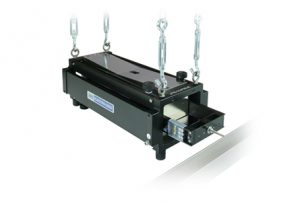
Free Body Mode
Key Features
- Suitable if the test object is in high altitude
- Accelerated shaker body inserts reaction force in the test structure
- Measurement of inserted force by a force transducer or the acceleration of the shaker body
The desired force input points on many test structures lie at a considerable distance above ground level. For tests on such items, it becomes difficult and expensive to use Fixed Body Mode support structures. For such applications, the Free Body Mode can be employed. In this mode the shaker body is used as the reaction mass by suspending the shaker from an overhead support. Besides using a force transducer a very convenient measure of the load force is the axial acceleration of the shaker body. This allows simplification of the test system instrumentation, in that force can be measured with an accelerometer system which is identical to that used to measure the structural response.
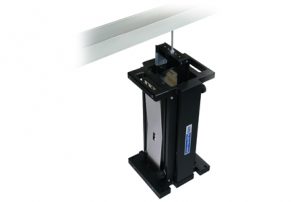
Fixed Body Mode
Key Features
- (Generated) shaker force applied directly to structure
- Low influence on structure due to low armature mass
- Measurement of delivered force by force transducer or shaker current
In the Fixed Body Mode, the shaker body is fixed and the armature is attached to the test structure. So shaker force is delivered directly in the test structure. In this mode, force delivered to the test structure can be measured by inserting a force transducer in the thrust linkage between the armature and test structure. Alternatively, with the armature/body suspension bands removed, shaker current can be used as a direct measure of the generated force. The generated force is approximately equal to the force delivered to a resonant test structure, because the armature mass is typically small compared to the modal mass of most large test structures.
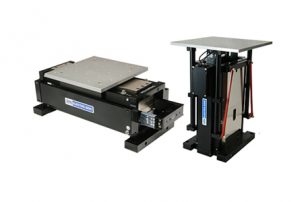
Shaker Table Mode
Key Features
- Horizontal and vertical long stroke tables
- Rugged design for harsh environment
- High payload – up to 20 kg
Auxiliary table accessory units for both horizontal and vertical use employ the high load capability of the APS 113 armature guidance and suspension systems to provide long stroke tables for excitation of test loads. Each auxiliary table has a pattern of threads with helical inserts to mount the test load directly or a fixture on the table. The mechanical input impedance at the base of a test load that is resonant in the operating frequency range can vary significantly. Thus, the acceleration response of the table and test item base will exhibit the familiar „peaks“ and „notches“ as frequency is varied. So it is recommended to observe the response of the structure using accelerometers.
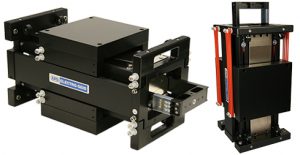
Reaction Mass Mode
Key Features
- Inertial vibration exciter
- Vertical or horizontal operation
- Easy to install reaction mass
Many large test structures having horizontal surfaces such as floors require vertical or horizontal force applied to these surfaces to generate resonant modes of vibration. The APS shakers may be used in a vertical or horizontal Free Armature Mode by resting the shaker body on the horizontal surface. The moving armature provides a reaction mass that allows for delivery of the shaker force via the shaker body to the surface (inertial shaker). Below a certain cross-frequency the shaker stroke limits the acceleration of the armature and thus the maximum force. Additional masses, e.g. APS 0112 or 4001, lower this frequency. The force applied to the structure can be measured by a force transducer or by measuring the acceleration of the moving masses.
Software
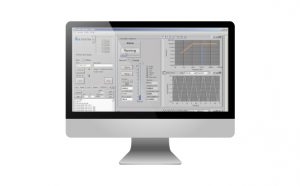
Flexible Software Components
SPEKTRA has software that is a perfect match to the National Instruments hardware. It is a LabVIEW-based software solution. So it can easily be integrated into your environment. The LabVIEW software package allows for driving several exciters
to achieve different physical measurements in parallel and updating the test system for further purposes as required. In addition you can use it for laboratory applications and scale it up to an automated test system.
- Scalable technology, from a very simple control unit up to a very high performance and multi-channel controller
- Operation modes: sine, random, shock, chart, FDR, …
- Coordinated synchronized multi-channel excitation, also synchronized 3-dimensional excitation possible
- Customer-specific individual extensions on request
Your Benefits
- Single and multichannel excitation
- Synchronized or individual channels
- Locked phase with adjustable and controlled phase shift for multiple I/O channels
- Earthquake simulation
- Field data replication (FDR)
- Multi-channel data acquisition
- Intuitive handling
- Database
- Remote control
- Synchronizing and trigger signals
- Reports & monitoring
- Frequency range 0.01 Hz – 95 kHz
- Integration of laser vibrometer
